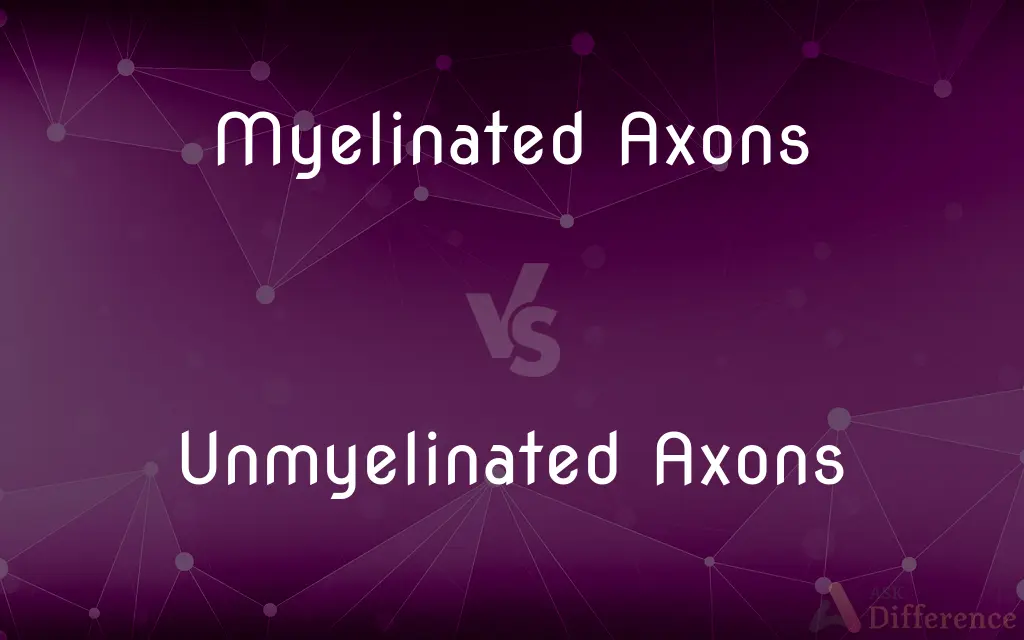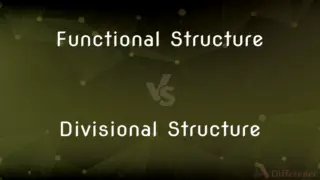Myelinated Axons vs. Unmyelinated Axons — What's the Difference?
By Tayyaba Rehman — Published on November 7, 2023
Myelinated axons are nerve fibers covered in a myelin sheath, enhancing signal speed and efficiency. Unmyelinated axons lack this sheath, resulting in slower nerve impulse conduction.

Difference Between Myelinated Axons and Unmyelinated Axons
Table of Contents
ADVERTISEMENT
Key Differences
Myelinated axons distinguish themselves through a unique structure wherein the nerve fibers are enveloped by a myelin sheath, fundamentally facilitating accelerated and more efficient nerve impulse transmissions throughout the nervous system. Contrarily, unmyelinated axons, devoid of this fatty insulating layer, conduct nerve impulses at notably slower velocities, impacting the speed and efficiency with which sensory or motor information is transmitted throughout the organism.
The presence of the myelin sheath in myelinated axons not only expedites neuronal communication by enabling saltatory conduction, where nerve impulses jump between gaps in the myelin, but also provides a protective role for the underlying nerve fiber. Unmyelinated axons, due to the absence of myelin, involve a continuous, slower transmission of nerve impulses and may be subject to different vulnerabilities due to the lack of an insulating and protective layer.
Energetically, myelinated axons confer a more efficient nerve transmission method, since the insulating myelin sheath reduces ion leakage and consequently, the metabolic demand for maintaining the resting membrane potential and repolarization after action potentials. Unmyelinated axons, conversely, might exhibit higher energy consumption due to continuous ion exchange along the entire axon, demanding persistent efforts to maintain electrochemical gradients.
Myelinated axons prominently feature in the vertebrate nervous systems, underpinning the rapid communication required for complex sensory and motor functions by reducing the time taken for nerve impulses to traverse extensive neural pathways. On the flip side, unmyelinated axons tend to predominate in invertebrate nervous systems, which, while serving sufficiently for their physiological needs, may limit the speed and complexity of neural communication.
Notwithstanding their differences, both myelinated and unmyelinated axons serve as critical communicative pathways within organisms, ensuring that sensory information is received and that motor commands are executed, albeit with disparities in speed and efficiency. Notably, myelinated axons are instrumental in facilitating complex, rapid physiological responses, while unmyelinated axons may be more prevalent in systems where rapid conduction is less critical or in shorter neural pathways.
ADVERTISEMENT
Comparison Chart
Myelin Sheath
Present and insulating
Absent
Speed of Conduction
Rapid due to saltatory conduction
Slower and continuous
Energy Efficiency
Higher due to reduced ion leakage
Lower due to continuous ion exchange
Predominant In
Vertebrate nervous systems
Often in invertebrate nervous systems
Complexity of Function
Facilitates complex, rapid responses
Adequate for simpler, slower communication
Compare with Definitions
Myelinated Axons
Axons enveloped in a myelin sheath.
Myelinated axons ensure rapid neural communication.
Unmyelinated Axons
Axons without a myelin sheath.
Unmyelinated axons transmit signals relatively slowly.
Myelinated Axons
Typically found in vertebrates.
Humans possess numerous myelinated axons.
Unmyelinated Axons
Adequate for simpler neural pathways.
Unmyelinated axons suffice for basic sensory transmission.
Myelinated Axons
Integral for fast, complex neural pathways.
Myelinated axons facilitate rapid reflex actions.
Unmyelinated Axons
Features continuous conduction.
Impulses travel without jumping in unmyelinated axons.
Myelinated Axons
Efficient in energy usage during conduction.
Myelinated axons conserve energy due to reduced ion exchange.
Unmyelinated Axons
Commonly found in invertebrates.
Invertebrates like worms have unmyelinated axons.
Myelinated Axons
Characterized by saltatory conduction.
Nerve impulses jump between nodes in myelinated axons.
Unmyelinated Axons
Utilize more energy for impulse transmission.
Unmyelinated axons engage in continuous ion exchange.
Common Curiosities
What is the main function of the myelin sheath?
Myelin sheaths enhance signal speed and protect the axon in myelinated axons.
How does myelin improve energy efficiency?
Myelin reduces ion leakage and the energy cost of maintaining ion gradients in myelinated axons.
Why are myelinated axons faster?
Myelinated axons exhibit faster conduction due to saltatory conduction facilitated by the myelin sheath.
Do unmyelinated axons have a protective layer?
Unmyelinated axons lack the protective myelin sheath found on myelinated axons.
How does myelin affect nerve impulse conduction?
In myelinated axons, myelin enables nerve impulses to jump between gaps, speeding conduction.
Are unmyelinated axons found in humans?
Yes, humans have both myelinated and unmyelinated axons, each serving different functions.
Where are myelinated axons primarily located?
Myelinated axons are widely distributed in the nervous systems of vertebrates.
Are myelinated axons necessary for complex actions?
Myelinated axons often facilitate the rapid conduction needed for complex actions.
Can diseases target the myelin sheath?
Yes, some diseases, like multiple sclerosis, target myelin in myelinated axons.
Which organisms predominantly possess unmyelinated axons?
Invertebrates commonly feature networks of unmyelinated axons in their nervous systems.
Are unmyelinated axons always slower?
Generally, yes—unmyelinated axons conduct impulses slower than myelinated ones.
Can unmyelinated axons facilitate reflex actions?
Unmyelinated axons can participate in reflexes, though potentially slower than myelinated ones.
Is the lack of myelin in unmyelinated axons disadvantageous?
While unmyelinated axons conduct slower, they are functional and vital in various organisms.
Do unmyelinated axons utilize more energy?
Yes, unmyelinated axons generally consume more energy due to continuous ion exchange.
Are unmyelinated axons simpler in structure?
Yes, unmyelinated axons are structurally simpler due to the absence of a myelin sheath.
Share Your Discovery

Previous Comparison
Functional Structure vs. Divisional Structure
Next Comparison
Conditioned Stimulus vs. Unconditioned StimulusAuthor Spotlight
Written by
Tayyaba RehmanTayyaba Rehman is a distinguished writer, currently serving as a primary contributor to askdifference.com. As a researcher in semantics and etymology, Tayyaba's passion for the complexity of languages and their distinctions has found a perfect home on the platform. Tayyaba delves into the intricacies of language, distinguishing between commonly confused words and phrases, thereby providing clarity for readers worldwide.











































